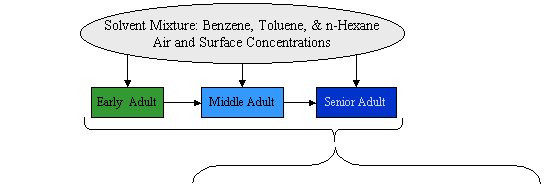
![]() 4.0 Scenarios
4.0 Scenarios
4.1 Life Stages
4.2 Scenario 1
Model Flow Diagram 1
4.3 Scenario 2
Model Flow Diagram 2
4.4 Scenario 3
Model Flow Diagram 3
4.5 Scenario 4
Model Flow Diagram 4
4.6 Process Flow
4.7 Gap Analysis
4.4 Scenario 3


Scenario 1
Scenario 2
Scenario 3
Scenario 4
Scenario 3
This section provides the conceptual model for the exposure pathways associated with Exposure Scenario 3. The conceptual model and associated assumptions are critical in determining the type of the models, algorithms, and databases required to satisfy the needs of the modeling scenario. Figure 4.4 provides an illustration of the conceptual model for Exposure Scenario 3.
Occupational Indoor Smoking Description
- Smokes 15-20 cigarettes per day since age 18, including 60% indoors and 10% outdoors at home and 30% indoors at work
Adhesive Compounding Facility Description
- Blending of solvent-based adhesive in 700,000 ft3 room
Occupational Exposure to VOC Compound Group D
- Compound Group D solvent mixture: benzene, toluene, n-hexane
- Exposure from routine compounding and hourly product sampling
- Exposure from cleaning agitator blades 2-3 times/wk with one of solvents
- Exposure during cleaning of spill 2-3 times/yr of cleaning solvent (1 gal), compounding solvent (30 gal), or product (50 gal)

Assumptions about Working Conditions
- Work facility has separate smoking room
- Separate lunch room and no food or tobacco allowed in work area
- Attached shower/locker room with same heating/ventilation system as manufacturing room, where worker stores lunch and cigarettes
- Worker wears protective coveralls, neoprene gloves & apron, goggles, and full-face respirator with organic vapor cartridge to fill drums
- Worker adds protective full-face, positive-pressure SCBA and Tyvek coveralls for blade cleaning & spills
- Works typical schedule and hours
Adult Age Timeline
- Early Adult (18-35 years)
- Middle Adult (35-50 years)
- Senior Adult (50-65 years)
Notes
-Question: Exposure to solvent mixture at different intervals of time can/cannot cause harmful health effects. The longer the exposure the greater the potential for toxicity.
- Health effects will be calculated for the adult age 18 through 65. Depending on model outputs, this can be a cumulative time distribution or a time-weighted value.
---- Exposure from routine compounding and hourly product sampling.
---- Exposure from cleaning agitator blades 2-3 times/wk with one of solvents.
---- Exposure during cleaning of spill 2-3 times/yr of cleaning solvent (1 gal), compounding solvent (30 gal), or product (50 gal).
Figure 4.4.3 CCEF Model Flow Diagram Scenario 3
